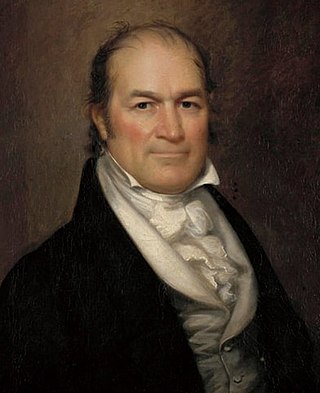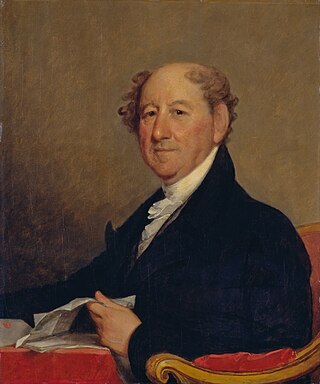
The 1816 United States presidential election was the eighth quadrennial presidential election. It was held from November 1 to December 4, 1816. In the first election following the end of the War of 1812, Democratic-Republican candidate James Monroe defeated Federalist Rufus King. The election was the last in which the Federalist Party fielded a presidential candidate.

The 14th United States Congress was a meeting of the legislative branch of the United States federal government, consisting of the United States Senate and the United States House of Representatives. It met in the Old Brick Capitol in Washington, D.C. from March 4, 1815, to March 4, 1817, during the seventh and eighth years of James Madison's presidency. The apportionment of seats in the House of Representatives was based on the 1810 United States census. Both chambers had a Democratic-Republican majority.

William Harris Crawford was an American politician and judge during the early 19th century. He served as US Secretary of War and US Secretary of the Treasury before he ran for US president in the 1824 election.
The 1816–17 United States House of Representatives elections were held on various dates in various states between April 30, 1816 and August 14, 1817. Each state set its own date for its elections to the House of Representatives before the first session of the 15th United States Congress convened on December 1, 1817. The size of the House increased to 184 after Indiana and Mississippi achieved statehood.
Thomas Flournoy Foster was an American politician and lawyer.

The 1816–17 United States Senate elections were held on various dates in various states. As these U.S. Senate elections were prior to the ratification of the Seventeenth Amendment in 1913, senators were chosen by state legislatures. Senators were elected over a wide range of time throughout 1816 and 1817, and a seat may have been filled months late or remained vacant due to legislative deadlock. In these elections, terms were up for the senators in Class 2.

The 1816 United States House of Representatives elections in New York were held from April 23 to 25, 1816, to elect 27 U.S. Representatives to represent the State of New York in the United States House of Representatives of the 15th United States Congress. At the same time, a vacancy was filled in the 14th United States Congress.

Pennsylvania elected its members October 8, 1816.

Maryland elected its members October 6, 1816.

North Carolina elected its members August 14, 1817.

Ohio elected its members October 8, 1816.

In December 1816, a special election was held in Georgia's at-large district to fill a vacancy left by the resignation of Alfred Cuthbert (DR) on November 9. Cuthbert himself had been elected in a special election in 1813.

On December 15, 1815, having been elected to the Senate, Nathaniel Macon (DR) of North Carolina's 6th district resigned. To fill the vacancy left in North Carolina's representation for the 14th Congress, a special election was held on January 22, 1816.

On April 16, 1816, Richard Stanford (DR) of North Carolina's 8th district died in office. A special election was held to fill the resulting vacancy

The newly created state of Indiana elected its sole member of the U.S. House of Representatives in August 1816, in advance of statehood, to represent Indiana's at-large congressional district.

A special election was held in New York's 21st congressional district April 30-May 2, 1816 to fill a vacancy left by the resignation of Peter B. Porter (DR) on January 23, 1816 after being appointed a Commissioner under the Treaty of Ghent. The special election was held at the same time as the general elections to the 15th Congress in New York.

The 1816 United States elections elected the members of the 15th United States Congress. Mississippi and Illinois were admitted as states during the 15th Congress. The election took place during the First Party System. The Democratic-Republican Party controlled the Presidency and both houses of Congress, while the Federalist Party provided only limited opposition. The election marked the start of the Era of Good Feelings, as the Federalist Party became nearly irrelevant in national politics after the War of 1812 and the Hartford Convention.

The 1816 United States presidential election in Indiana took place between November 1 to December 4, 1816, as part of the 1816 United States presidential election. The state legislature chose three representatives, or electors to the Electoral College, who voted for President and Vice President.

The 1816 United States presidential election in Massachusetts took place between November 1 and 3, 1816, as part of the 1816 United States presidential election. Voters chose 22 representatives, or electors to the Electoral College, who voted for President and Vice President.
This page is based on this
Wikipedia article Text is available under the
CC BY-SA 4.0 license; additional terms may apply.
Images, videos and audio are available under their respective licenses.













